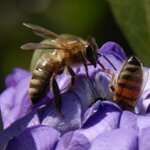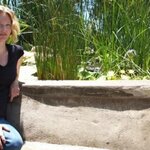Ecology & Zoology

A new paper has found that two broad-spectrum systemic insecticides, fipornil and imidacloprid, may be impacting honeybees.
Fipronil, part of the phenylpyrazole chemical family, is a highly effective insecticide which can be applied at very low doses for everything from crop to veterinary pests. Imidacloprid is in the class of chemicals called neonicotinoids - it mimics nicotine, which can be toxic to sucking insects like fleas and termites but has no effect on mammals. Recently, there has been concern about colony collapse disorder (CCD) in honeybees - this also happened decades ago…

More than 10,000 reptile species have been recorded into the Reptile Database, a web-based catalog of all living reptile species and classification, making the reptile species among the most diverse vertebrate groups in the world, alongside bird and fish species, and likely the largest known.
Experts projected that 2014 would mark the year that reptiles would become the most diverse vertebrate group in the world. Reptiles include snakes, lizards, turtles, crocodiles, tuataras and amphisbaenians.
"Officially, we have logged 10,038 reptile species into the database, which is up from 9,952 that…

This Bobtail squid was imaged by the Deep Discover ROV in Atlantis Canyon, is less than one foot in length.This bobtail squid is very surprised at the absence of squid gynaecologists! Image credit: NOAA OKEANOS Explorer Program
I first saw squid pimples in 2006, on a research cruise in the Sea of Cortez. The little bumps around the female's mouth looked exactly like whiteheads, as if squid could get clogged pores. They even oozed white stuff when you squeezed, but it wasn't pus.
It was sperm.
I was just beginning as a graduate student, learning to extract eggs and sperm from Humboldt squid in…

Hibiscus flowers are an iconic symbol of tropical resorts worldwide but some are rather rare. Hawaii's State Flower, Hibiscus brackenridgei, is an endangered species.
Everyone knows of the Hawaiian hibiscus but few are aware of an equally beautiful and intriguing related group of plants known as Hibiscadelphus- literally "brother of Hibiscus".
Brother of Hibiscus is highly endangered. Until recently only one of the seven previously known species remained in its natural habitat, the other having gone extinct. These trees are only known, or were known, from five of the eight main Hawaiian…

Bumblebees can glean differences in pollen quality based on floral features like petal color and that informs their decision on where to land.
Bees do not sample pollen so it has been unclear how they determined quality. The new study in the Journal of Experimental Biology found that they are able to form associative relationships between appearance and pollen quality. Bumblebees can individually assess pollen samples and discriminate between them during collection, quickly forming preferences for a particular type of pollen.
Pollen foraging behavior involves learning and individual decision-…

Before the European colonial era, the people who lived on the land now called California used fire to control growth and make sure they had food, fuel, tools, and objects for ritual.
The Miwok people of the Sacramento Valley created a fire and flood system. To maintain the blue and valley oak, they had an anthropogenic fire system, which is something that was lost in recent California history, when activists protested to make sure no logging or maintenance could be done, and which led to runaway wildfires. Primitive people who couldn't read or write were still smarter than…

Acoustic disturbance has different effects on different species of fish, according to a new study which tested fish anti-predator behaviour.
Three-spined sticklebacks responded sooner to a flying seagull predator model when exposed to additional noise, whereas no effects were observed in European minnows.
Lead author Dr. Irene Voellmy of Bristol's School of Biological Sciences said, "Noise levels in many aquatic environments have increased substantially during the last few decades, often due to increased shipping traffic. Potential impacts of noise on aquatic ecosystems are therefore…

In Aesop's fable about the crow and the pitcher, a thirsty bird happens upon a vessel of water, but when he tries to drink from it, he finds the water level out of his reach. Not strong enough to knock over the pitcher, the bird drops pebbles into it — one at a time — until the water level rises enough for him to drink his fill.
Highlighting the value of ingenuity, the fable demonstrates that cognitive ability can often be more effective than brute force. It also characterizes crows as pretty resourceful problem solvers. New research conducted by UC Santa Barbara's Corina Logan, with her…

Mammoths and mastodons, the famously fuzzy relatives of elephants that lived in the American midwest, weren't as nomadic as previously believed – or Cincinnati was just a great place to be at the end of the last ice age. A study led by Brooke Crowley, an assistant professor of geology and anthropology at the University of Cincinnati, shows the ancient proboscideans enjoyed the area so much they likely were year-round residents and not nomadic migrants as previously thought.
They even had their own preferred hangouts. Crowley's findings indicate each species kept to separate areas…

The size and age of plants has more of an impact on their productivity than temperature and precipitation, according to a landmark study by University of Arizona researchers.
Professor Brian Enquist and postdoctoral researcher Sean Michaletz, along with collaborators Dongliang Cheng from Fujian Normal University in China and Drew Kerkhoff from Kenyon College in Gambier, Ohio, have combined a new mathematical hypothesis with data from more than 1,000 forests across the world to show that climate has a relatively minor direct effect on net primary productivity, or the amount of biomass that…